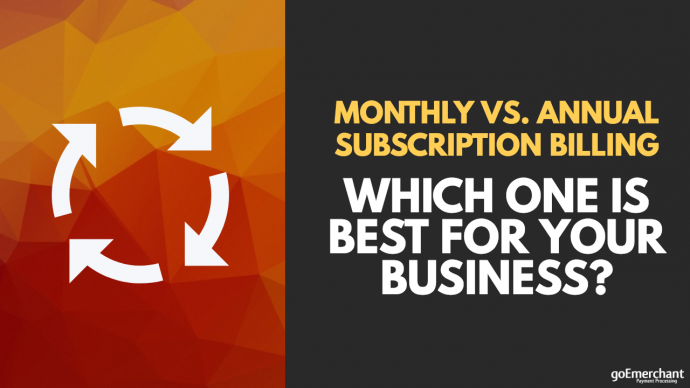Subscription billing can be a lucrative payment tool for merchants looking to build customer loyalty and increase cash flow. One of the only challenges is deciding which path is best for your customers: Monthly or annual billing?
Like most scenarios in the world of customer payment models, there are pros and cons to each method. The biggest pro, however, is that whatever route your business decides on, there are significant advantages that can help build your customer base and increase revenue.
Subscription commerce as an industry only continuing to grow, which has made recurring billing the norm for many businesses. Businesses have realized the value of making one-time customers repeat buyers by locking them into becoming regular customers.
The benefits of subscription billing are apparent for most businesses. To start, recurring billing models ensure funds are regularly flowing into your merchant accounts. Once you’ve got a customer hooked on a product or service, there’s more of a chance they’ll stay loyal to your business since they don’t have to remember to continually purchase from your company.
To help you wade the subscription billing question about which is better, we’ll break down all the factors you’ll need to consider before choosing your path.
Table of Contents
Benefits of Monthly Subscription Billing
The most significant advantage of implementing a monthly subscription billing model is there are lower up-front costs for your customer. Since some consumers are wary of signing up for long-term commitments, having the ability to pay monthly offers less risk to those customers who aren’t ready to fully commit.
Since customers are paying monthly, this casts a broader customer net over the number of shoppers who are willing to engage with the product or service. This can help drive up acquisition numbers, and increases the chances you’ll keep them coming back month after month. For a company launching a new product or service, a monthly option allows customers to have a proof-of-concept before they agree to buy into the larger business model.
From a business standpoint, monthly subscription billing also assures that funds are flowing into your accounts on a regular basis. This can help your relationships across the payments ecosystem and also help your business calculate what your revenues will be each month. From an accounting and budgeting standpoint, this can be easier to manage.
Drawbacks of Monthly Subscription Billing
There’s an obvious drawback of monthly subscription billing that businesses shouldn’t overlook. Having a lower barrier to entry can also make it easier to bail on that subscription. For companies trying to market new products and services, allowing customers to choose if they want to keep the option on a monthly basis makes it much easier for them to cancel.
Since building customer loyalty is a prime benefit of monthly subscription billing, merchants must consider if offering a monthly option makes it too easy for customers to try the product or service once and cancel the account after a short trial. Customer acquisition is more costly than customer retention, which is one drawback businesses must weigh before deciding on a billing model.
Benefits of Annual Subscription Billing
The most significant advantage of implementing an annual subscription billing is the guarantee that you’ve secured that customer for a more extended period. This helps ease cash flow concerns and assures revenue is set for that specific customer for a defined period. From an accounting standpoint, annual subscription billing also helps reduce internal costs associated with monthly invoicing or payment collection.
Annual billing can also help establish a defined customer loyalty strategy. Offering an annual option shows your customers that you have a model that’s tested and proven to last in the market, which can help assure them that your business is reliable and well received by other customers. In general, annual billing is less of a headache to manage.
An annual subscription model is also one way to market a lower price point to your customers. As a way to entice customers to engage with your service at a lower fee, businesses typically offer an annual subscription at a lower rate than the monthly. Usually, businesses provide both an annual subscription and monthly subscription, so they’re customers are empowered to choose the model that works best for them.
Drawbacks of Annual Subscription Billing
The biggest drawback to annual subscription billing is the upfront costs to customers. Since an annual commitment requires more money at once, this might turn some customers away. For customers who are wanting to test a product or service before they entirely buy into the model, annual billing might be too much of a commitment.
Annually billing might also cause some logistical issues on the dispute side. Since a customer may forget they made an annual commitment to a specific service, when that bill shows up the second time, they may forget what it is for and dispute the charge. This can lead to friction in your payment processes, and increase the chance for chargebacks.
Choosing the Right Subscription Billing Model
Regardless of which model is right for your business and your customers, you can rest assured that the benefits of subscription billing outweigh the drawbacks. All businesses are focused on customer acquisition and retention, and a subscription billing model can help boost both.
Subscription billing can also help your business diversify its payment types since the payment processing partners that offer the best recurring business models also have flexible payment method integration. They also allow your customers to provide flexibility in when and how they want to pay for that subscription. Regardless of which route you choose, it’s important to focus on delivering transparent practices, so customers know when, how and why they are being billed for a specific product and service.
Keeping sign up easy, and terms simple will help increase customer loyalty and decrease the chance they’ll dispute a recurring billing charge. It will also give your business better peace of mind that revenue will be flowing into your accounts on a regular basis.




